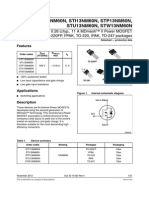Grade 10 Subject-Science CHAPTER - 10 Light - Reflection and Refraction Notes
Uploaded by
luv manotGrade 10 Subject-Science CHAPTER - 10 Light - Reflection and Refraction Notes
Uploaded by
luv manotGRADE 10
SUBJECT- SCIENCE
CHAPTER- 10 Light- Reflection and Refraction
NOTES
Introduction
● Light is a form of energy due to which we are able to see the objects which emit light for example
objects like sun, lamp, candle emits light of their own and thus they are known as luminous objects.
● There are objects like table, chair, etc. which are not luminous objects and still, we are able to see them
and this happens because they reflect lights which falls on them from a luminous object like sun, lamp,
etc. and when this reflected light reaches our eyes we are able to see such non-luminous objects.
● Light rays basically consist of electromagnetic waves that do not require any material medium (like
solid, liquid, or gas) for their propagation.
Reflection of Light
● The process of sending back light rays which fall on the surface of an object is called REFLECTION of
light
● Silver metal is one of the best reflectors of light.
● Mirrors we use on our dressing tables in our home are plane mirrors.
● A ray of light is the straight line along which the light traveled and a bundle of light rays is called a
beam of light.
Laws of Reflection of light
1. The angle of incidence is equal to the angle of reflection, and
2. The incident ray, the reflected ray and the normal to the mirror at the point of incidence all lie in
the same plane.
● These laws of reflection are applicable to all types of reflecting surfaces including spherical surfaces
Real and Virtual images
● An image is formed when the light rays coming from an object meet at a point after reflection from a
mirror (or refraction from the lens).
● The images are of two types
1. Real Images:- Real images are formed when rays of light that come from an object (or source)
meets at a point after reflection from a mirror (or refraction from a lens). Real images can be
formed on a screen and can be seen with the eyes.
2. Virtual images:- Virtual image is an image in which the outgoing rays from an object do not
meet at a point. It will appear to meet at a point in or behind the optical device (i.e., a mirror) but
they do not actually meet after reflection from a mirror (or refraction from a lens). A plane
mirror always forms virtual images.
Page 1 of 19
Characteristics of images formed by mirrors:-
● (a) Images formed by mirrors are always virtual and erect
(b) Size of image is always equal to the size of the object and the image is laterally inverted.
(c) The images formed by the plane mirror are as far behind the mirror as the object in front of the
mirror.
● Lateral inversion:- If an object is placed in front of the mirror, then the right side of the object appears
to be the left side, and the left side of the object appears to be the right side of this image. This change of
sides of an object and its mirror image is called lateral inversion.
Spherical Mirrors
● The reflecting surface of a spherical mirror may be curved inwards or outwards.
● Spherical mirrors are of two types
1. Concave mirror: - In a concave mirror reflection of light takes place at the concave surface or bent-in
surface as shown below in the figure.
2. Convex mirror:- In a convex mirror reflection of light takes place at the convex surface or bent out surface as
shown below in the figure.
Page 2 of 19
● Commonly used terms about Spherical mirrors:-
1. Center of curvature: - The reflecting surface of a spherical mirror forms a part of a sphere. This
sphere has a center. This point is called the center of curvature of the spherical mirror. It is
represented by the letter C. Please note that the center of curvature is not a part of the mirror. It
lies outside its reflecting surface. The center of curvature of a concave mirror lies in front of it.
However, it lies behind the mirror in the case of a convex mirror as shown above in figure 2.
2. Radius of curvature: - The radius of the sphere of which the reflecting surface of a spherical
mirror forms a part, is called the radius of curvature of the mirror. It is represented by the letter
R.
3. Pole: - The center of a spherical mirror is called its pole and is represented by letter P as can be
seen in figure 2.
4. Principle axis: - Straight line passing through the pole and the center of curvature of a spherical
mirror is called principal axis of the mirror.
5. Aperture of the mirror: - Portion of the mirror from which reflection of light actually takes place
is called the aperture of the mirror. Aperture of the mirror actually represents the size of the
mirror.
Page 3 of 19
Principle focus and focal length of a Spherical Mirrors
● For understanding about principle focus and focus length of a spherical mirror first consider the figure
given below
● From figure 3a we see that a number of rays parallel to the principal axis are falling on a concave mirror.
If we now observe the reflected rays we see that they are all intersecting at a point F on the principal
axis of the mirror. This point is called the principal focus of the concave mirror.
● In the case of a convex mirror, rays get reflected at the reflecting surface of the mirror and these
reflected rays appear to come from point F on the principle axis and this point F is called the principal
focus of the convex mirror.
● The distance between the pole and the principal focus of a spherical mirror is called the focal length. It is
represented by the letter f.
● There is a relationship between the radius of curvature R, and focal length f, of a spherical mirror, and is
given by R=2f which means that that the principal focus of a spherical mirror lies midway between the
pole and center of curvature.
Image Formation by Spherical mirrors
● The nature, position and size of the image formed by a concave mirror depend on the position of the
object in relation to points P, F and C.
● The image formed can be real as well as virtual depending on the positions of the object.
● The image is either magnified, reduced or has the same size, depending on the position of the object.
Rules for obtaining images formed by spherical mirrors
(1) Rule 1
A ray of light which is parallel to the principle axis of the mirror passes through its focus after reflection from
the mirror as shown below in the figure
Page 4 of 19
From the figure given above it can be clearly seen that the light rays passes through principle focus in case of
concave mirrors and appears to diverge from principle focus in case of concave mirror.
(2) Rule 2
A ray of light passing through the center of curvature of the curvature of the concave mirror or directed in the
direction of the center of curvature of a convex mirror, is reflected back along the same path as shown below in
the figure
This happens because the incident rays fall on the mirror along the normal to the reflecting surface.
(3) Rule 3
A ray passing through principle focus of a concave mirror or a ray which is directed towards the principal focus
of a convex mirror, becomes parallel to the principle axis after reflection and is shown below in the figure
Page 5 of 19
(4) Rule 4
A ray incident obliquely to the principal axis, towards a point P (pole of the mirror), on the concave mirror or a
convex mirror, is reflected obliquely. The incident and reflected rays follow the laws of reflection at the point of
incidence (point P), making equal angles with the principal axis and is shown below in the figure
Image formation by spherical mirrors
Image formation by concave mirror
● The type of image formed by a concave mirror depends on the position of the object kept in front of the
mirror. We can place the object at following places
1. Between pole P and focus F
2. At the focus
3. Between focus F and center of curvature C
4. At the center of curvature
5. Beyond center of curvature
6. At far off distances called infinity and cannot be shown in the figures
Page 6 of 19
● Image formation by a concave mirror for different positions of the object is shown below in the table
● Concave mirrors are used as shaving mirrors, reflectors in car headlights, hand torch and table lamps.
● Large concave mirrors are used in field of solar energy to focus sun rays on objects to be heated.
Image formation by convex mirrors
● In order to construct a ray diagram to find out the position, nature and size of image formed by convex
mirror we should remember following path of rays of light.
● A ray of light parallel to the principle axis of a convex mirror appears to be coming from its focus after
reflection from the mirror.
● A ray of light going towards the center of curvature of convex mirror is reflected back along its own
path.
● Convex mirrors have its focus and center of curvature behind it and no light can go behind the convex
mirror and all the rays that we show behind the convex mirror are virtual and no ray actually passes
through the focus and center of curvature of the convex mirror.
● Whatever be the position of object in front of convex mirror, the image formed by a convex mirror is
always behind the mirror, virtual, erect and smaller than the object.
● Nature, position and relative size of the image formed by a convex mirror is given below in the table
● Convex mirrors are used as rear view mirrors in automobiles to see the traffic at back side as they give
erect images and also highly diminished one giving the wide field view of traffic behind.
Page 7 of 19
Sign convention for reflection by spherical mirrors
Reflection of light by spherical mirrors follow a set of sign conventions called the New Cartesian Sign
Convention. In this convention, the pole (P) of the mirror is taken as the origin. The principal axis of the mirror
is taken as the x-axis (X'X) of the coordinate system. The conventions are as follows -
● The object is always placed to the left of the mirror. This implies that the light from the object falls on
the mirror from the left-hand side.
● All distances parallel to the principal axis are measured from the pole of the mirror.
● All the distances measured to the right of the origin (along + x-axis) are taken as positive while those
measured to the left of the origin (along - x-axis) are taken as negative.
● Distances measured perpendicular to and above the principal axis (along + y-axis) are taken as positive.
● Distances measured perpendicular to and below the principal axis (along -y-axis) are taken as negative.
These new Cartesian sign convention for spherical mirrors are shown below in the figure
Mirror formula and magnification
Mirror formula:-
It gives the relationship between image distance (v) , object distance (u) and the focal length (f) of the mirror
and is written as
Where v is the distance of image from the mirror, u is the distance of the object from the mirror and f is the
focal length of the mirror. This formula is valid in all situations for all spherical mirrors for all positions of the
object.
Page 8 of 19
Magnification
Magnification produced by a spherical mirror gives the relative extent to which the image of an object is
magnified with respect to the object size. It is expressed as the ratio of the height of the image to the height of
the object. It is usually represented by the letter m. So,
The magnification m is also related to the object distance (u) and image distance (v) and is given as
m= h1= - v
h2 u
Refraction of light
● We know about light and also know that light travels in a straight line path in a medium or two different
mediums with same density.
● Now a question arises what happens when light travels from one medium to another with different
densities for example from air to glass.
● When light ray is made to travel from one medium to another say from air to glass medium then light
rays bend at the boundary between the two mediums.
● So, the bending of light when it passes from one medium to another is called Refraction of light.
● The refraction of light takes place on going from one medium to another because the speed of light is
different in two media.
● Medium in which speed of light is more is called optically rarer medium and medium in which speed of
light is less is known as optically denser medium. For example glass is an optically denser medium than
air and water.
● NOTE:- When light goes from rarer medium to denser medium it bends towards the normal and when it
goes from denser medium to rarer medium it bends away from the normal.
Page 9 of 19
You might also like
- Hourglass Workout Program by Luisagiuliet 276% (21)Hourglass Workout Program by Luisagiuliet 251 pages
- Read People Like A Book by Patrick King-Edited57% (82)Read People Like A Book by Patrick King-Edited12 pages
- Livingood, Blake - Livingood Daily Your 21-Day Guide To Experience Real Health77% (13)Livingood, Blake - Livingood Daily Your 21-Day Guide To Experience Real Health260 pages
- Donald Trump & Jeffrey Epstein Rape Lawsuit and Affidavits83% (1016)Donald Trump & Jeffrey Epstein Rape Lawsuit and Affidavits13 pages
- The 36 Questions That Lead To Love - The New York Times94% (34)The 36 Questions That Lead To Love - The New York Times3 pages
- The 36 Questions That Lead To Love - The New York Times95% (21)The 36 Questions That Lead To Love - The New York Times3 pages
- Jeffrey Epstein39s Little Black Book Unredacted PDF75% (12)Jeffrey Epstein39s Little Black Book Unredacted PDF95 pages
- 14 Easiest & Hardest Muscles To Build (Ranked With Solutions)100% (8)14 Easiest & Hardest Muscles To Build (Ranked With Solutions)27 pages
- The 4 Hour Workweek, Expanded and Updated by Timothy Ferriss - Excerpt23% (954)The 4 Hour Workweek, Expanded and Updated by Timothy Ferriss - Excerpt38 pages
- Edited Ch 9 Light Reflection and Refraction Notes 1 Docx EditedNo ratings yetEdited Ch 9 Light Reflection and Refraction Notes 1 Docx Edited21 pages
- Physics Class X Reference Study Material Pages DeletedNo ratings yetPhysics Class X Reference Study Material Pages Deleted174 pages
- Physics-Class-X-Reference-Study-Material BEST PDFNo ratings yetPhysics-Class-X-Reference-Study-Material BEST PDF177 pages
- CHAPTER 10 Light-Reflection and RefractionNo ratings yetCHAPTER 10 Light-Reflection and Refraction14 pages
- Copy of physics-class-x-reference-study-materialNo ratings yetCopy of physics-class-x-reference-study-material187 pages
- Light Reflection and Refraction CBSE Class 10 Science Revision Notes Chapter 10No ratings yetLight Reflection and Refraction CBSE Class 10 Science Revision Notes Chapter 1010 pages
- [CLASS DISCUSSIONS]LIGHT REFLECTION AND REFRACTIONS (NOTES)No ratings yet[CLASS DISCUSSIONS]LIGHT REFLECTION AND REFRACTIONS (NOTES)17 pages
- Light Reflection & Refraction Padhai Ak Mazza Best Handwritten Notes for 2025 Board ExaminationNo ratings yetLight Reflection & Refraction Padhai Ak Mazza Best Handwritten Notes for 2025 Board Examination17 pages
- Reviewer For The Types of Mirrors and Lenses and Their PropertiesNo ratings yetReviewer For The Types of Mirrors and Lenses and Their Properties10 pages
- Candid Education Class X TH Reflection A PDFNo ratings yetCandid Education Class X TH Reflection A PDF5 pages
- Light Reflection & Refraction Padhai Ak Mazza Best Handwritten Notes for 2023 Board ExaminationNo ratings yetLight Reflection & Refraction Padhai Ak Mazza Best Handwritten Notes for 2023 Board Examination11 pages
- Chapter 9 - Light - Reflection and RefractionNo ratings yetChapter 9 - Light - Reflection and Refraction4 pages
- Differences Between Specular and Diffused ReflectionNo ratings yetDifferences Between Specular and Diffused Reflection4 pages
- Qualitative Characteristics of Images Formed by MirrorsNo ratings yetQualitative Characteristics of Images Formed by Mirrors6 pages
- Cylindrical Perspective: Cylindrical Perspective: Exploring Visual Perception in Computer VisionFrom EverandCylindrical Perspective: Cylindrical Perspective: Exploring Visual Perception in Computer VisionNo ratings yet
- Rittal TOP Therm: Maillefer Doc. 550 0510X.1No ratings yetRittal TOP Therm: Maillefer Doc. 550 0510X.119 pages
- Insulation Resistance Testing: How and Why?: 27 Comments - Related ContentNo ratings yetInsulation Resistance Testing: How and Why?: 27 Comments - Related Content2 pages
- 1000micrometers 1 Milimeter: SB015 Pre-Lab ModuleNo ratings yet1000micrometers 1 Milimeter: SB015 Pre-Lab Module6 pages
- Objective Physics II-Year Class: (Full Book)No ratings yetObjective Physics II-Year Class: (Full Book)2 pages
- Advanced Analog & Digital Design Workstation: Instruction ManualNo ratings yetAdvanced Analog & Digital Design Workstation: Instruction Manual16 pages
- Fiberglass Hot Sticks: Standard SpecificationsNo ratings yetFiberglass Hot Sticks: Standard Specifications4 pages
- Refere'Nce Classa3, O Classa6.0: Power AmplifiersNo ratings yetRefere'Nce Classa3, O Classa6.0: Power Amplifiers20 pages
- Corrosion Assessment of Steel Bars Used in Reinforced Concrete Structures by Means of Eddy Current TestingNo ratings yetCorrosion Assessment of Steel Bars Used in Reinforced Concrete Structures by Means of Eddy Current Testing18 pages
- Efficiency Optimization Method For Cascaded Two-Stage Boost ConverterNo ratings yetEfficiency Optimization Method For Cascaded Two-Stage Boost Converter11 pages























































































































